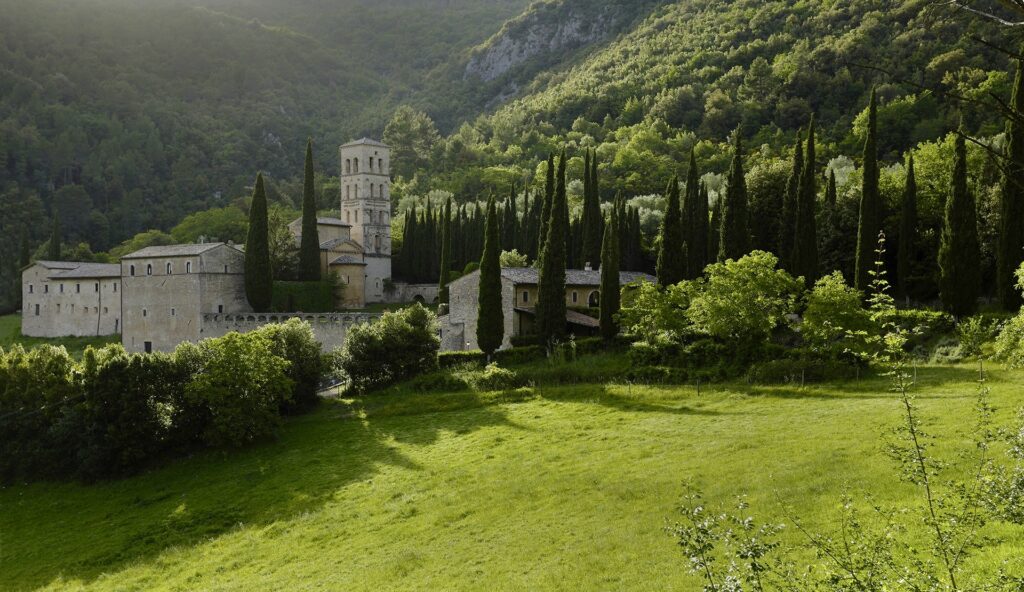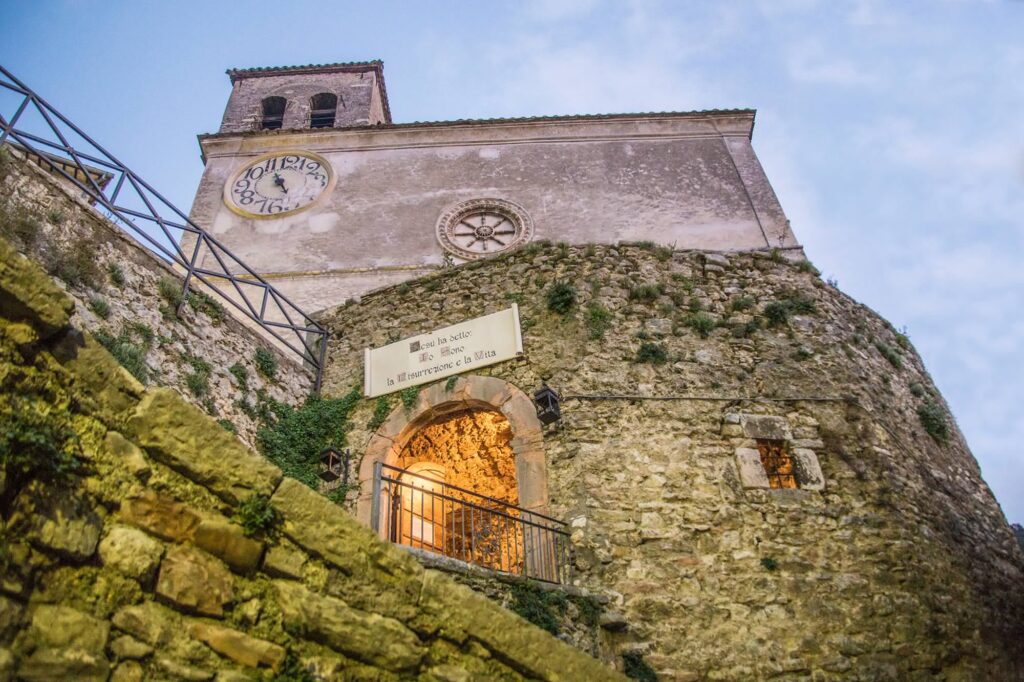
By Francesco Bianchini

Precetto (left), Matarella (right), guarding the entrance to the Valnerina.
To the south of Norcia, the Valnerina narrows to a gorge between rocky cliffs. Here, clinging to the granite feet of the surrounding mountains is the village of Ferentillo—in actuality two hamlets divided by the Nera river, Mattarella on the right and Precetto on the left. Each boasts its own church, ruined watchtowers, and crumbling bastions designed to defend the Abbey of San Pietro in Valle located in the narrow rift beyond. It was to visit the monastery one autumn day that I hitchhiked to Ferentillo, playing hooky from school in Terni only because the abbey’s romantic facade, framed by oaks and cypresses, graced the cover of the telephone book that year. The driver kindly dropped me at the edge of the village, indicating that I could get to the abbey on foot, which I proceeded to do. But a large wooden sign inscribed with a directional arrow and one intriguing word arrested my progress: Mummies. I made a mental note to investigate what lay behind the odd announcement, but by the time I returned to Ferentillo it was well after noon.

The abbey of San Pietro in Valle.
“The mummies are closed for lunch,” I was told in the village, so I sat down to eat a sandwich on the steps of Precetto’s church of Santo Stefano. Presently, I found myself staring at the dilapidated crypt door, fastened with an ancient padlock and surmounted by another old metal sign. Emblazoned thereon, as if to the portal of a Dantean Hades, was the alarming message:To you tomorrow, today to me. What you are, I was; I am what you will be. Remember, mortal, this is your doom: your time is coming soon.When opening time came I knocked, as directed, at a house opposite the crypt. An old man emerged—appropriately, the color of a cadaver—grasping in his hand a clutch of long keys. Signor Dario Orsi, guardian of the mummies, led me through the battered door, his sole visitor on that luminous October afternoon.

The church of Santo Stefano, and the entry to the crypt.
We entered the crypt—in fact, a cave supported by stout pillars of the church above, with a floor of soft earth, illuminated by narrow apertures overlooking the valley. In the dim light, I barely could discern a row of what seemed like petrified mannequins, misshapen figures leaning haphazardly against the damp stonewalls. Some were standing on the tamped-down dirt, some were enclosed in old-fashioned display cases—skeletons covered by thin wan parchment, stiffened in bizarre positions, with their limbs tied, more often than not, with kitchen twine to prevent them falling apart. The bodies are from one to four centuries old, I was told, and the last corpse to be interred lies in a casket bearing the date May 18, 1871. My guide in that underworld—pointing in passing to teeth, fingernails, hair, beards, braids, and remnants of clothing intact—explained that the phenomenon at Ferentillo has long been studied, with the conclusion that all conditions necessary for spontaneous mummification are present. Bacterial spores enriching the soil help dry the tissues and kill the usual agents of decomposition; moreover, the crypt benefits from exceptional ventilation provided by the small openings facing the river.
Why aren’t these people properly buried? I asked. According to Orsi, the parishioners of Santo Stefano discovered their mummified antecedents under the church in the late 19th century. Sensing the allure—more likely the chance to make a lira or two—they sought and received permission to retain them, in situ. Amid this gallery of characters—a Spoon River Anthologyon the banks of the Nera—Signor Orsi relates the local ‘take’ on each individual, pontificates about the morality (or lack thereof) of each life, and enthusiastically repeats the apocryphal. “See that one with his head bent back over his shoulder,” Orsi asked me. “His name was Serafino, a disreputable crook, son of a leather merchant. His father warned him of the risks of a dissolute life, but bandits murdered the old man and his fatherly advice went unheeded. As fate would have it, the young man wholly wasted his inheritance and hanged himself on Christmas Eve in the branches of a plane tree. That’s why his neck is all screwed around.” Next to Serafino is the body of a Frenchman, a deserter from Napoleon’s army, with marks of torture on his legs and arms. “When he was discovered hiding in the woods, the villagers dragged him here and beat him pretty badly,” Orsi reported. “After all, he was invading our country, wasn’t he?”

Horror and desperation are etched on the hollow faces and gaping mouths of Ferentillo’s mummies, conveying the dreadful idea of premature burial, or at least a painful method of death. For a time, I was haunted by the image of a woman who I assumed had been buried alive—her hands grasp at her rib cage and her mouth is frozen in a cavernous spasm, as if gasping for air. I was relieved to learn the truth from Orsi, however: many of the mummies have their mouths wide-open for the simple reason that the villagers did not bind their jaws shut. Then there is Giacomo, the village bell ringer who was killed by falling from the church tower on the morning of Corpus Christi, and also the shriveled corpse of a woman mown down by the plague. She has traces of the disease—marks like cigarette burns, head-to-toe —covering her skin. Reposing in a casket is the mummy of a lawyer named Bucci whose descendants still dwell in the village. He was killed in an attack so violent that no less than twenty-seven stab wounds puncture his body. Next to Bucci, ironically, lies the remains of a fellow named Stefanaccio who was one of the lawyer’s assailants. His torso seems writhing eternally in pain, with his hands clutching the spot on his groin where he was inadvertently stabbed by one of his fellow attackers.
There is also a certain Master Francesco whose head is cocked sideways and mouth deformed by some incurable ailment. He never married, Orsi confided, preferring the company of a servant boy—his ‘dandy’—and two stable hands. “He ate continuously and was crazy for the doughnuts the women here make for the Feast of Saint Anthony—the ones made with flour, white wine, olive oil, and a handful of anise and citron. An old beggar woman put a curse on him because he denied her one. Soon after, he just popped off and died.” A prostrate figure in the next case is that of Caterina, daughter of one of Francesco’s stable boys. She died in childbirth, unmarried and shamed, and is displayed with her stillborn babe lying beside her. Finally, there is a hunchback named Severino, one of the last people buried in Ferentillo’s communal grave, who was just pitched there on top of the rest. His head tilts forward a full ninety degrees and protrudes over a bulging stomach. His face has the color of aged ham but still sports a nose, well-modeled cheekbones, eyelids, and chin covered by a scraggly beard. Perhaps oddest in all the collection, however, are the deformed bodies of a Chinese couple, husband and wife, along with the head (all that remains) of their Asian manservant. Resembling some kind of expressionist sculpture, the petrified pair is now embarked on an endless pilgrimage to Rome, having died of cholera while journeying to the Papal Jubilee of 1750.

The poor woman and her baby.
Cesare Pavese wrote of death that it is the decisive instant from the forest of personal symbols that has detached one with violence and has stuck, nailed it forever, to the soul. Of Ferentillo’s mummies one might say:here is Lust with Sloth as companion; there lies Gluttony unlamented. Envy departed without regret. Yea, I was Wrath and my Nature led me here. Or, like Masters:ye aspiring ones, listen to the story of the unknown who lies here with no stone to mark the place.In other words, if you care to visit Hell, here is a convenient package tour; if you desire to pass judgment, every deadly sin is personified in the poor mummies of Ferentillo—none of them conjure images of pharaohs permeated with bitumen, wrapped in gauze bandages, or composed for a dignified eternity in sculpted and gilded sarcophagi. These Umbrian mummies are something different, bespeaking violent deaths, disease, and the pitiless corruption of time—just poor naked people.







